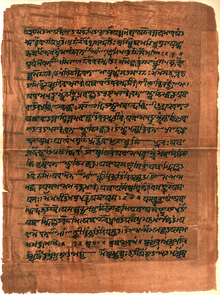
Indian medicine: the Atharva Veda manuscript: an Indian medical book
Early Indian medicine
Medicine got an early start in India. Even in the Stone Age, about 5000 BC, dentists at Mehrgahr were drilling people’s teeth. They tried to fix people’s cavities. That’s in the Indus River Valley (now in Pakistan).
Where is Mehrgahr?
History of medicine
The Atharva Veda
About 1000 BC, doctors in northern India wrote the Atharva veda, a medical textbook explaining how to treat diseases. Like Egyptian medical texts a little earlier, the Atharva veda says that diseases are caused by bad spirits.
Egyptian doctors and medicine
You treat the disease by killing the spirits with poisons or spells. One example is the treatment of skin diseases with a kind of lichen. The lichen might have worked as an antibiotic. Another example is the treatment of snakebite by reciting charms. Possibly Yamnaya people brought marijuana with them when they came to India, about this time.
Who were the Yamnaya people?
The history of marijuana
The surgeon Sushruta

An Indian woman with cataracts covering her eyes.
The surgeon Sushruta may have lived about 500 BC. Sushruta left a book, the Samhita, explaining his surgical methods. Sushruta described how to pull teeth, how to fix broken bones, and how to fix blockages of the intestines. He did operations on people’s eyes to remove cataracts. These cataract operations sometimes worked a little, though more often they left the patient completely blind.
India in 500 BC
Sushruta’s operations must have been very hard, because he didn’t have any anesthesia other than wine. But he recommended bhang (probably marijuana) to treat coughs and dysentery.
History of wine
What is dysentery?
Sushruta also described tuberculosis. About the same time, Indian people were using sand and charcoal filters to get clean water. That probably saved many lives.
What is tuberculosis?
How do you make charcoal?

Indian medicine: Replicas of the surgical tools Sushruta describes in his book
Charaka and dosha (humors)
By about 200 AD, Indian doctors, like Chinese doctors and Greek doctors, had abandoned the idea of bad spirits. Instead, they believed the somewhat less wrong idea of dosha or humors. The doctor Charaka wrote maybe about this time. Charaka recognized that prevention was the best cure for many diseases. He recommended keeping your humors in balance in order to stay healthy.

A type of citron called Buddha’s Hand
Charaka recognized three humors – bile, phlegm (snot), and air. If your humors got out of balance, you should take medicines to rebalance them. But he also knew some medicines that worked: doctors recommended citrons to cure scurvy (That’s a Vitamin C deficiency).
Where do citrons come from?
Humors in ancient Greece
Doctors and medicine in ancient China
Medicine in the Roman Empire
Indian doctors were so much respected that Indian traders got rich selling Indian medicines to people in the Roman Empire, Iran, Sogdiana, East Africa, and China.
Medicines and the Silk Road

Indian herbal medicines
Blood and brains
By this time, Indian doctors also knew more about how your body worked. Charaka knew, probably from the work of earlier Egyptian doctors, that blood vessels both brought food to various parts of your body and also carried wastes away, and that your brain was for thinking.
Medieval anatomy studies
Smallpox and inoculation
Charaka also made the earliest Indian reference to smallpox, and this is just around the time that smallpox first devastated the Roman Empire, coming from the East. Under the Guptan kings, in the 300s AD, Chinese visitors praised India’s hospitals.
What was smallpox?

Child with smallpox (Bangladesh 1973)
Several hundred years later, Indian doctors were the first to invent a way to inoculate people against smallpox. In the 700s AD, a doctor called Madhav wrote about inoculation. Madhav knew that you could keep people from catching smallpox by scraping a little pus or scabs from someone who had smallpox, letting it sit around for a while, and then giving a small amount as an inoculation, either by sticking it into their skin on a needle, or by blowing the powder up their nose.
Inoculation and vaccination
Indian medicine meets Islamic medicine
When Muslims conquered northern India about 1000 AD, many Iranian doctors came to India from West Asia to work for Muslim kings there.
Medieval Islamic medicine
These doctors realized that the Indian list of humors didn’t match the Islamic list of humors, and tried to find out what was right. For example, some Muslim doctors began to include air as one of the humors, and to combine black bile and yellow bile as one humor.
Opium reaches India

Opium poppy flower
These Muslim doctors also brought opium and henbane (another anesthetic) with them to northern India, and by the 1200s AD, Indian doctors as far south as the Chola kingdom (as we know from the Sarangdhara Samhita) had learned to use opium both as an anesthetic and for diarrhea.
What is opium?
The doctor Lakshmana Pandita wrote in the early 1400s AD in the Vijayanagara Empire, under Imadi Bukka, the son of Hari Hari II. Lakshmana Pandita wrote about the different types of fevers, dysentery, miscarriages and fistulas, cancer, epilepsy, and kidney stones, among other things. Like doctors everywhere in Afro-Eurasia at this time, he thought you could tell what was wrong with patients by taking their pulse.





hello Um can you tell me how this Atharva Veda is still used
Well, people still use it in alternative medicine, to tell them what medicines to take for colds, asthma, arthritis, and so on. Most of the treatments don’t work, or have better modern equivalents that you can get from regular doctors.
Respected mam, regarding small correction as per my knowledge, The word Kushta of Sanskrit means skin disease in genand not just restricting to leprosy.
Acharya Sushrutha lived before Acharya Charaka, but Samhithas available today, charaka samhitha with a commentary of chakrapani js older than Sushrutha samhitha with Dalhana’s commentary.
And as per I know most of Ayurveda writtings are based on either other Ayurveda texts or on other Indian authentic texts and not by foreign country sciences.
I am an Ayurveda student, felt good seeing this buy just felt like giving some points i knew.
Thank you
Thank you for your contribution, Dr. Harshitha! I have changed the text from “leprosy” to “skin diseases” in general. Indian doctors were, however, always in touch with the doctors of other places, and they all learned from one another over time, as doctors do today.
heyo wassup my name is iufrlkjdrhm jhkrgherj